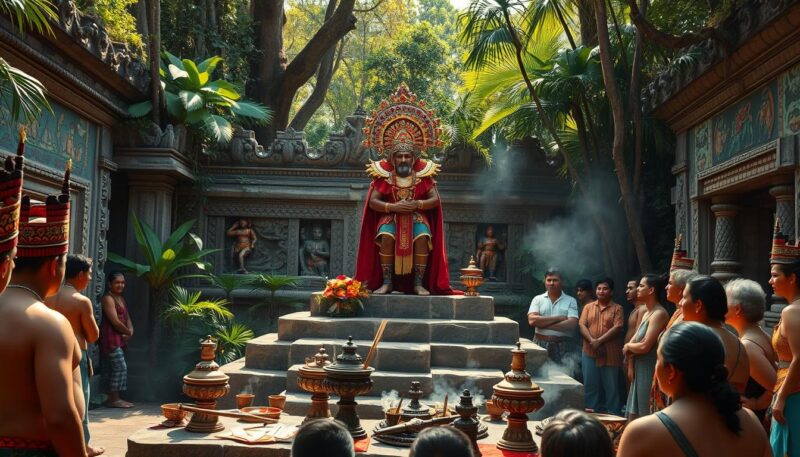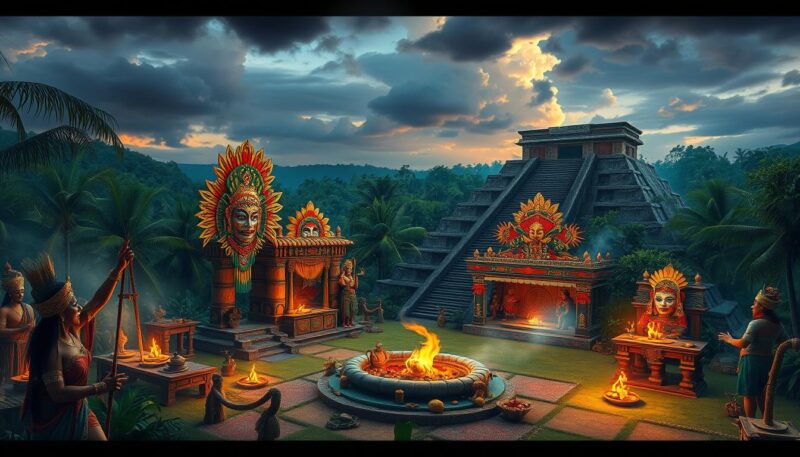The enigmatic world of the ancient Maya civilization, which flourished between 250 AD and 900 AD during the Classic period and continued through the Postclassic period until approximately 1500 AD, is palpable with intrigue and complexity. At the heart of this vibrant culture lay a profound spiritual landscape populated by a pantheon of gods, embodying the dualities of existence—both beneficial and harmful. The Maya deities held immense significance, influencing every realm of life, from agriculture to health, and the rituals for Mayan gods were intricately designed to sustain harmony with these powerful beings.
Through sacred ceremonies and ancient practices, the Maya sought to establish connections with these gods, whose diverse nature was depicted in artifacts and codices, including the revered Dresden, Madrid, and Paris codices. Each of these manuscripts preserves the rich tapestries of Mayan mythology, illustrating not only the dedication of the people but also the structured belief systems that categorized their universe into realms: the Upperworld, Earth, and Xibalba— the Underworld.
Understanding the Mayan worldview and the importance of their rituals reveals a society deeply intertwined with spiritual practices. The representation of these gods, often characterized by hybrid features, symbolizes the intricate interrelations among the deities. This article aims to explore the depth of ancient Mayan ceremonies, unearthing the various practices employed to connect with their gods, all to ensure favorable conditions. Join me as we delve into the remarkable rituals that captivated the hearts and minds of an entire civilization.
Understanding Mayan Gods and Their Significance
The pantheon of Mayan deities stands as a testament to the rich tapestry of ancient Maya beliefs. Each god and goddess played a crucial role in maintaining the harmony of the cosmic order, influencing everything from agricultural cycles to the rhythms of daily life. With over 250 deities recognized, the complexities of their mythology shed light on the relationship between humanity and the divine, fostering an understanding of the world through spiritual narratives.
Mythology and the Cosmic Order
Mayan mythology reveals an intricate web of relationships among the gods and natural phenomena. The creation stories often highlight significant events and occurrences, such as the creation of humanity from maize, underscoring the meaning of K’uh as it relates to divine power in Mayan religion. For example, both the Quiche and Yucatec Maya illustrate varying narratives regarding creation, reflecting their regional beliefs surrounding deities in Maya culture. The Temple of Kukulcan exemplifies this connection to the cosmic cycles, serving as a sacred site where thousands witness the serpent shadow each equinox, affirming the natural order.
The Role of K’uh in Mayan Religion
K’uh embodies the essence of divinity within the Mayan spiritual framework. This term encapsulates not just the gods but also the concept of the divine power Maya associated with specific areas of life. Worship practices Mayan often revolved around soliciting favor from these deities, whether for good harvest, victory in battle, or favorable weather. The dual nature of K’uh illustrates that the benevolence or wrath of deities could sway based on human action, reinforcing the need for reverence in rituals. Through the examination of codices and archaeological evidence, it becomes clear that the myriad forms of K’uh played a substantial role in shaping the societal structure, contributing to the evolving fabric of Mayan beliefs.
What Rituals Did the Maya Use to Please Their Gods?
The Maya civilization employed a rich tapestry of rituals aimed at appeasing their gods and ensuring harmony between their world and the divine. Central to these practices were bloodletting ceremonies, animal sacrifices, and the use of sacred cenotes. Each ritual reflected the Maya’s deep spirituality and their understanding of life, death, and the cyclical nature of existence.
Bloodletting Ceremonies and Human Sacrifice
Bloodletting ceremonies were crucial in the spiritual life of the Maya. Nobles and priests often inflicted wounds to offer their blood, considered a vital sustenance for the gods. Techniques varied, ranging from cutting earlobes to using materials like stingray spines for deeper wounds. The most precious offerings were those derived from the ears or tongues. In more severe circumstances, such as droughts, the human sacrifice Maya demonstrated their devotion through extreme rituals, often involving heart extraction atop pyramid summits. The gravity of these bloodletting ceremonies exemplified the Maya’s commitment to honoring deities in desperate times.
Animal Sacrifices and Offerings
Animal sacrifices Maya were integral to the Maya’s ritualistic framework. Rituals often included offerings from sacred animals like birds, deer, and even dogs. These creatures represented life force, vitality, and fertility, making their sacrifice a substantial gesture in the eyes of the gods. The act of offering extended beyond mere flesh; it embodied the Maya’s relationship with nature, symbolizing respect and gratitude. Through these practices, the Maya conveyed essential messages of their values and beliefs, reverberating through generations.
The Use of Sacred Cenotes
Sacred cenotes, natural sinkholes rich with symbolism, served as critical sites for rituals and offerings. Many believed these cenotes were portals to the underworld, connecting the Maya’s earthly existence to the divine. Archaeological evidence reveals numerous cenote offerings Maya, including artifacts, jade, and even human remains. These deposits highlight the cenotes’ role as spiritual gathering sites dedicated to water deities, portraying spirituality in cenotes as vital for agricultural abundance and community welfare. Such rituals encapsulated the Maya’s profound reverence for water, considering it a life-giving force essential for their survival.

Conclusion
In reflecting on the ancient Maya religion, the significance of rituals Maya conducted reveals a profound connection to their deities. Through a diverse array of ceremonies, including bloodletting, offerings, and the dramatic use of sacred cenotes, the ancient Maya maintained a delicate balance with their gods, striving to secure prosperity and agricultural fertility. These rituals not only were vital in honoring the gods but also reinforced the community’s social structure, linking the royal class to divine favor.
The extensive history of these practices, persisting for approximately 650 years, highlights the Mayans’ advanced understanding of astronomy and the cosmos. The intricate calendar system they developed ensured a harmonious rhythm between their agricultural activities and the cyclical nature of the environment. Even today, the legacy of Mayan rituals endures, resonating within contemporary Mayan communities and showcasing their rich heritage that continues to influence cultural practices in the region.
Overall, the rituals of the ancient Maya extend beyond mere performative acts; they encapsulate a worldview where spirituality, science, and community welfare converge. The enduring importance of these rituals underscores their role in crafting a complex society deeply intertwined with beliefs, traditions, and a reverence for the forces that govern their lives.

